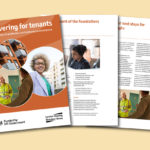London boroughs have launched a new shared vision for delivering high-quality landlord services for council tenants.
Led by the London Housing Directors’ Group with support from London Councils, Delivering for Tenants: The Foundations of an Effective Local Authority Landlord Service, sets out best practice principles on how boroughs can go beyond their statutory and regulatory responsibilities to deliver the highest possible housing standards.
Acknowledging instances of poor practice and the massive challenges facing the social housing sector, the report reiterates London boroughs’ commitment to ensuring tenants are listened to and services respond efficiently and effectively to their needs.
More than one in every 10 homes in the capital is let by a local authority [1]. Boroughs are proud of their role as social housing providers, which is crucial for tackling homelessness and inequality by helping lower-income residents afford to live in the capital.
However, London’s social housing faces acute pressures and research for London Councils suggests tenant satisfaction levels in London are lower than the rest of the country. The capital accounts for 19% of England’s social housing stock, but between April 2019 and March 2021, 57% of all damp and mould maladministration cases (a formal decision against a social landlord) reported by the Housing Ombudsman were in London (across all types of social housing provider).
Boroughs highlight that a key factor driving these figures is the poor state of London’s social housing stock. Housing in the capital is generally older than elsewhere in the country; there is a higher proportion of flats, which makes maintenance more complex; and London’s severe housing pressures mean the capital has higher rates of overcrowding.
On top of this, boroughs point to the impact of worsening resource pressures. London local authorities’ Housing Revenue Accounts — through which all income and spending related to council housing must be recorded — are forecast to be almost £600m worse off over the next five years as a result of the 7% rent cap introduced by government on the social housing sector in 2023-24.
The rent cap worsens an already difficult financial position for councils, with the annual 1% rent reduction policy in place from 2016 to 2020 leaving rental income across London HRAs an estimated £459m lower in 2021-22 than it would otherwise have been.
Even within this hugely difficult context, boroughs recognise there is more they must do to deliver high standards, to ensure tenants’ voices are heard and acted upon, and to co-ordinate their landlord services with the council’s wider strategic objectives for their local communities — from supporting economic development through to raising housing conditions and securing net zero carbon objectives.
Delivering for Tenants aims to support this collective ambition. Produced through consultation with London local authority housing officers, councillors, and tenants from across the capital, the report proposes five key themes for supporting an effective local authority landlord service: vision and strategy; leadership; management; performance and compliance; and assurance.
Cllr Darren Rodwell, London Councils’ Executive Member for Regeneration, Housing & Planning, said: “Boroughs are proud social landlords. Social housing is a vital part of London’s infrastructure that provides affordable homes for hundreds of thousands of Londoners.
“However, the social housing sector is under massive pressure. Too often we have seen examples of tenants living in poor-quality housing and receiving a substandard service. Our tenants deserve better. Everyone should have a home that they can be proud of. This report will help us make that ambition a reality and I am grateful to everyone — especially tenants — who contributed to putting it together.
“When it comes to deciding the future of social housing in London, national policy and investment decisions remain fundamental factors. Boroughs will continue to work with ministers on this important agenda and push for the funding required to support our shared goals.”
Joanne Drew, Co-Chair of the London Housing Directors’ Group, commented: “No one can doubt the huge challenges facing social housing in the capital, but boroughs are working with each other and tenants to try and drive up standards. Our homes and tenant services must be good quality, and our relationship with tenants needs to be positive and built on partnership.
“As housing leaders in the capital, we’ve taken the chance to reflect and identify a way forward. Delivering for Tenants sets out our shared vision of how we can be most effective as council landlords. We are committed to continue listening, learning, and adapting as we raise standards and seek better outcomes for Londoners.”
[1] In total there are 717,000 social rented homes in London — accounting for 20% of the capital’s 3,671,000 homes. London boroughs own around 390,000 of those social homes (the rest being owned by housing associations).
[2] London Councils is holding an online event to mark the launch of Delivering for Tenants. This will be held on Thursday 13th April from 3.30-5pm. More details can be found here.
[3] Delivering for Tenants can be downloaded from the London Councils website here.
On average at least one child in every classroom in the capital is homeless, according to analysis from London Councils released in March. More on that story here.










